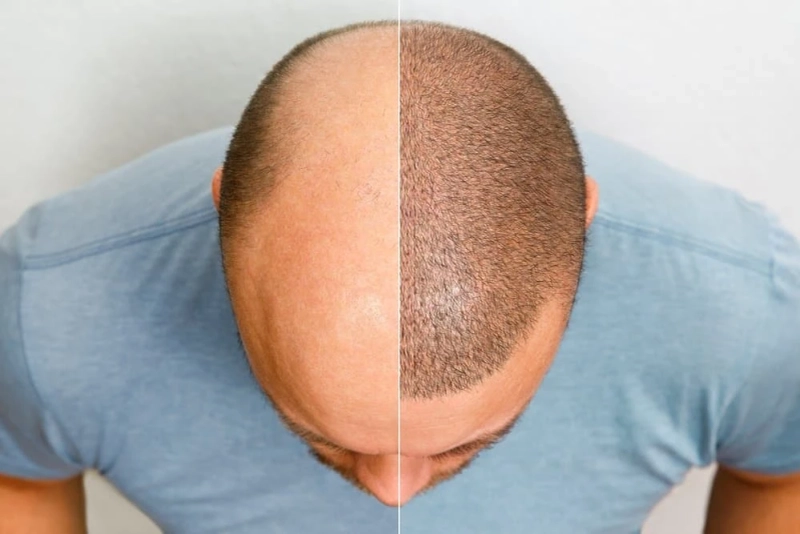A hair transplant is a surgical procedure in which hair follicles from a donor area, typically the back or sides of the scalp, are removed and moved to a balding or thinning area of the scalp. Depending on the size of the transplant, the procedure can take several hours and is typically carried out under local anaesthesia. Read on to learn more about aftercare tips of Hair Transplants here:
Methods:
Follicular unit transplantation (FUT) and follicular unit extraction are the two main hair transplantation techniques (FUE) techniques. FUT involves removing a strip of scalp from the donor area, extracting the individual hair follicles, and transplanting them to the recipient area. FUE involves the direct removal of individual hair follicles from the scalp using a punch tool and their transplantation to the recipient area.
Why Is Hair Transplant Done?
To treat baldness or hair loss, hair transplants are performed. Usually done for aesthetic purposes to enhance hair appearance and boost self-confidence. Hair transplants can offer a solution that enables people to restore their hair and feel more confident. Hair loss can have a significant impact on a person\'s self-esteem and quality of life.
Male and female pattern baldness, hair loss caused by trauma or scarring, and other types of hair loss can all be treated with hair transplantation. The most typical cause of hair loss in both men and women, androgenetic alopecia, can be effectively treated with it. Due to the effects of dihydrotestosterone, the hair follicles in this condition shrink and eventually stop producing hair (DHT). Hair transplantation can move hair follicles from DHT-resistant regions of the scalp, such as the sides or back, to balding areas where hair growth has stopped.
In general, hair transplantation is a secure and efficient procedure that can offer a durable remedy for baldness, enabling patients to regrow their hair and regain their self-confidence.
10 Recommendations for Hat-Wearing After Transplant:
A surgical procedure called hair transplantation involves removing hair from one area of the scalp and transplanting it to another area of the scalp that is balding or losing hair. It\'s crucial to take good care of newly transplanted hair after a hair transplant to ensure that it grows in properly and appears natural. Wearing hats is one aspect of post-transplant care. Here are ten suggestions for wearing hats following a hair transplant:
Avoid hats for the first few days:
After a hair transplant, it is essential to give your scalp time to heal. For the first few days after the procedure, it is best to avoid wearing any hats that could put pressure on your scalp.
Wear a loose-fitting hat:
When you do start wearing hats after a hair transplant, make sure they are loose-fitting. Tight hats can put pressure on the transplanted hair and cause damage or dislodgement.
Choose a breathable hat:
Look for hats made from breathable materials like cotton or mesh. This will help to prevent sweating and reduce the risk of infection.
Avoid hats with seams:
Seams in hats can rub against the scalp and cause irritation or damage to the newly transplanted hair. Look for seamless hats or hats with minimal seams.
Avoid hats that are too hot:
Wearing a hat that is too hot can cause sweating and increase the risk of infection. Choose a hat that is lightweight and breathable.
Don\'t wear a hat for too long:
While it is important to protect your scalp from the sun and other elements after a hair transplant, it is also important not to wear a hat for too long. Take breaks from wearing your hat throughout the day to give your scalp a chance to breathe.
Use a hat to protect your scalp from the sun:
The sun can be damaging to the scalp, especially after a hair transplant. Use a hat to protect your scalp from the sun\'s harmful rays.
Use a hat to protect your hair from the wind:
Wind can be harsh on newly transplanted hair. Use a hat to protect your hair from the wind and prevent it from becoming tangled or damaged.
Avoid wearing hats at night:
Wearing a hat while you sleep can put pressure on your scalp and interfere with the healing process. It is best to avoid wearing a hat at night.
Choose a hat that complements your style:
Finally, when choosing a hat to wear after a hair transplant, consider your personal style. Choose a hat that complements your style and makes you feel comfortable and confident.
If you\'re thinking about getting a hair transplant, it\'s crucial to do your research and pick a reputable, skilled surgeon. SKN Cosmetics Islamabad is one of many companies that offer hair transplant services, and they might have some unique advantages that make them stand out from the competition. When selecting a hair transplant provider, take into account elements like the surgeon\'s training and experience, the facility\'s amenities, the before-and-after photos of previous patients, and the provider\'s general reputation and level of patient satisfaction.



